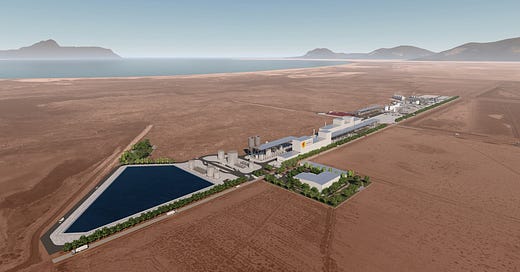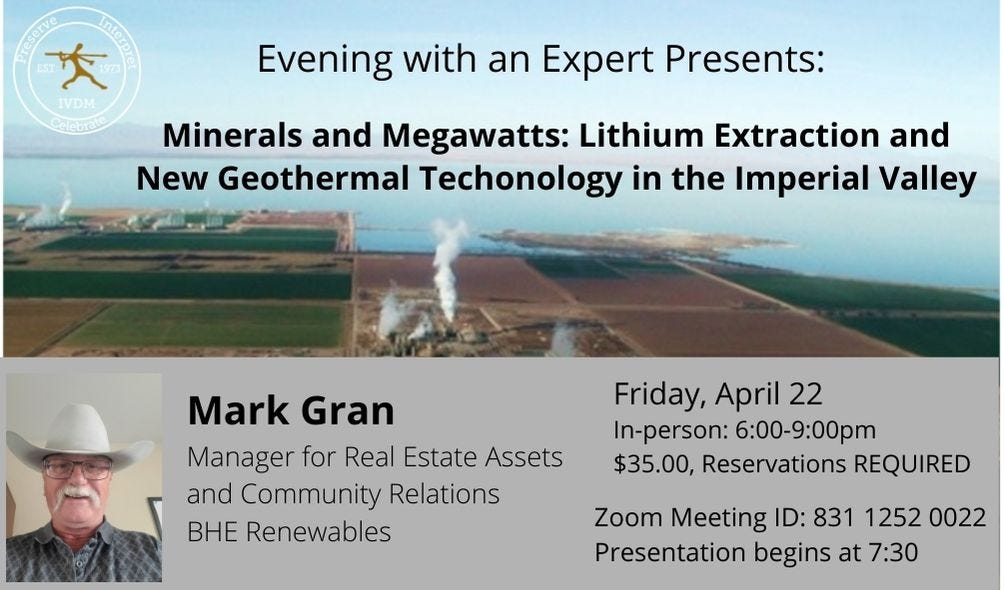Issue 7: Environmental review of CTR’s Hell’s Kitchen geothermal plant begins
Before Controlled Thermal Resources can build its ambitious lithium extraction and geothermal plant, it must undergo an environmental impact process required by law.
Fresh this Week
CTR’s Hell’s Kitchen Plant and Its Impact to the Environment
Before Controlled Thermal Resources builds its Hell’s Kitchen Geothermal Plant, pictured above, it needs to go through a rigorous approval process. That process is called an environmental review, one that looks at all the various ways that such a plant could disturb or affect the environment and the people around.
And CTR is about to begin that process. This week, Imperial County’s Planning & Development Services Department recommended that CTR undergo an environmental review of its construction plans in accordance with the California Environmental Quality Act, or CEQA.
A public meeting to discuss this review process will be held on April 28 at 6 p.m. at the Imperial County’s office at 801 Main Street in El Centro.
Berkshire Hathaway and TerraLithium
Last week, Bloomberg reported that Berkshire Hathaway, parent company of BHE Renewables and CalEnergy Resources, became the biggest shareholder of oil producer Occidental Petroleum Corp.
As you may know, CalEnergy operates 10 geothermal plants in the Salton Sea and is one of three companies pursuing lithium extraction in the region.
While the Bloomberg story raises the possibility of Warren Buffet’s motive to outright buy Occidental and venture into big oil, there is yet another possible motivation: lithium.
Enter TerraLithium:
Per its website, TerraLithium is a joint venture between All-American Lithium and Oxy Low Carbon Ventures, a wholly owned subsidiary of the Occidental Petroleum Corporation.
For its part, TerraLithium has been awarded a set of patents for pre-treatment of brine, which is considered the foundation of direct lithium extraction.
Lithium extraction technologies are considered a trade secret and, as such, some believe the patents raise the stakes for those companies extracting the mineral from the brine in the Salton Sea.
So, I wondered, is it BHE Renewables’ intention to be on the safe side and avoid any patent issues down the lithium extraction process? I asked this to Jonathan Weisgall, Vice President for Legislative and Regulatory Affairs for Berkshire Hathaway Energy, but he declined to comment.
Lithium Valley Facebook Group Reaches 130+ Members
More than 130 members of the Imperial Valley community have joined the Facebook Group dedicated to sharing information and fostering conversations around lithium in the region. This week alone added 62 new members, which includes community organizers and industry experts.
If you would like to join the discussion or learn what questions are raised, feel free to join.
Want to join the discussion on developments of the Lithium Valley? Join the Facebook Group and subscribe to this newsletter for a fresh batch of news every Friday.
Between the Lines
Using Water to Extract Lithium
Just how much water will it take to produce one ton of lithium? The exact number is still an elusive figure given that the technology to extract lithium is still being tested and could take a while to get a straight answer.
However, a Reuters report from this week points to one possible figure: 10 tons of water per 1 ton of lithium. If one ton of water is equal to 748 gallons of water, then 10 tons of water is equal to 7,480 gallons of water — which is a small fraction of water that the average person uses in a year.
Lilac Solutions Inc., an Oakland-based company that is backed by BMW and Bill Gates’ Breakthrough Energy Ventures, said it could use “a desalination plant to filter brackish water” as a way to avoid using potable water shared by Imperial Valley residents.
For those keeping track, CTR is using Lilac Solutions’ technology to extract lithium from the Salton Sea geothermal region and it has yet to extract lithium at a commercial level.
BHE Renewables, which oversees the 10 CalEnergy geothermal plants in the Salton Sea region, says it will take 50,000 gallons of water to make one ton of lithium. If that number is correct, that means that CalEnergy’s lithium extraction process uses far more water than Lilac Solutions’ method.
What kind of impact will this have on the water that Imperial Valley residents use? Well, that’s hard to say. In one previous edition of this newsletter, I took a look at just how much water the Imperial Irrigation District, or IID, distributes to households in the region.
And while there is not much of a difference between the quantity of water that residents use versus the water that geothermal operators use, geothermal expert Michael McKibben says the companies may use other sources of water to make lithium extraction sustainable, including IID canal water, non-potable shallow groundwater or steam-condensed water from the geothermal process itself.
All that said, there are two important takeaways to remember:
One is that the amount of water that residents and geothermal operators use in the Imperial Valley is a small fraction of what agriculture consumes — agriculture uses 96% of the water distributed by the IID, versus 4% of what residents and geothermal operators use.
And two, the environmental impacts of lithium extraction in the Salton Sea are significantly smaller than those in other places like Chile and Australia.
Lithium’s Promises and Challenges in the Imperial Valley
It is easy to get carried away by the promises that lithium extraction offers in the Imperial Valley — a venture worth billions of dollars in profits and a potential windfall that could bring some much needed jobs and relief to a region that suffers some of the highest unemployment rates in the nation.
But before those lofty promises can be fulfilled, one thing must happen first: a successful commercial-level production of lithium at any one of the several geothermal plants in Imperial County. And that has not yet happened.
Part of the reason why it has not happened is because the three companies pursuing lithium extraction here in the region are realizing that the geothermal brine underground is a major chemical engineering challenge.
To achieve direct lithium extraction, or DLE, the highly corrosive and mud-like brine coming from the ground needs to be purified and filtered. Otherwise, some components like silica, iron, manganese, and suspended solids can cause problems in the lithium extraction process.
This type of purification uses processes employed at geothermal brine sites for decades but have not yet been applied in DLE at the commercial level anywhere partly because the brine in the Salton Sea geothermal field is far hotter and more chemically complex than brines from other places.
There are a number of new DLE technologies which require careful implementation of this type of technology, and that will require years of engineering and pilot testwork to achieve.
Movements to Watch
The Imperial Valley Desert Museum is hosting an “evening with an expert” from BHE Renewables, the parent company of CalEnergy Renewables which oversees 10 geothermal plants near the Salton Sea. Mark Gran, Manager for Real Estate Assets and Community Relations for BHE Renewables will be speaking there on Friday, April 22, from 6-9 p.m.
And although the Imperial Valley Desert Museum receives funding from the state and the federal government, this is not a free community event. Fees to attend are $35 for members and $40 for non-members.
Want to stay updated on developments of the Lithium Valley? Join the Facebook Group and subscribe to this newsletter for a fresh batch of news every Friday.





